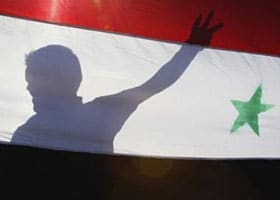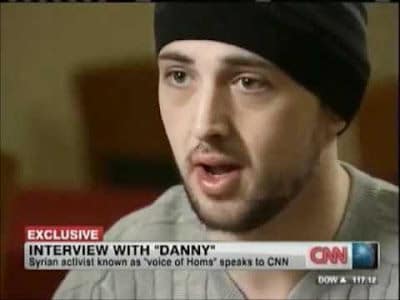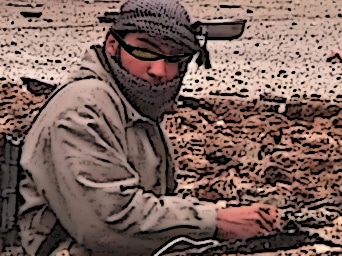EDITOR’S NOTE: As the drama in Syria intensifies, we are finally getting glimpses of the remarkable stage-craft that is going into propping up this one-sided storyline. The BBC just reported that armed opposition groups have planted explosives in Idlib, which has been touted as the scene for the next regime brutalities. But Sharmine Narwani brings us detailed testimony from within Idlib last Sunday that these fighters were laying down IEDs in and around civilian buildings as well. Why bomb homes except to create the impression of massive damage by regime forces?
The plot thickens, but still, few are asking the hard questions on Syria.
Do people want to go behind the velvet curtain and see the strings – or are they content to be simply led by the entertainment?
by Sharmine Narwani
 Last October I was asked to write an article on the direction of the crisis in Syria – a month later, I had still not made it beyond an introductory paragraph.
Last October I was asked to write an article on the direction of the crisis in Syria – a month later, I had still not made it beyond an introductory paragraph.
Syria was confusing.
The public discourse about events in the country appeared to be more hyperbole than fact.
But even behind the scene, sources strained to provide informed analyses, and it was fairly evident that a lot of guesswork was being employed.
By December, it occurred to me that a big part of the problem was the external-based opposition and their disproportionately loud voices. If you were actually in the business of digging for “verified” information on Syria last year, you would have also quickly copped on to the fact that this wing of the Syrian opposition lies – and lies big.
This discovery coincided with a new report by US intelligence analyst Stratfor that claimed: “most of the opposition’s more serious claims have turned out to be grossly exaggerated or simply untrue, thereby revealing more about the opposition’s weaknesses than the level of instability inside the Syrian regime.”
I had another niggling feeling that just wouldn’t quit: given the amount of regime-initiated violence and widespread popular dissent being reported in the mainstream media, why was the Syrian death toll so low after 10 months of alleged brutality?
Because, if the regime was not engaging in the kind of reckless slaughter suggested by activists, it would appear that they were, in fact, exercising considerable restraint.
Stratfor said that too. The risk analysis group argues that allegations of massacres against civilians were unlikely because the “regime has calibrated its crackdowns to avoid just such a scenario. Regime forces,” Stratfor argues, “have been careful to avoid the high casualty numbers that could lead to an intervention based on humanitarian grounds.”
For me, the events in Homs in February confirmed rather than contradicted this view. The general media narrative was very certain: there was a widescale civilian massacre in Baba Amr caused by relentless, indiscriminate shelling by government forces that pounded the neighborhood for weeks.
The videos pouring out of the besieged city were incriminating in the extreme. Black smoke plumes from shelling choked the city, piled up bodies spoke of brutal slaughter; the sound of mass wailing was only interrupted by explosions, gunfire and cries of “Allahu Akbar.”
But when it was over, we learned a few things. Contrary to reports during the “siege,” there were only a few thousand civilians in Baba Amr at the time – all others had already evacuated the area. The International Committee for the Red Cross (ICRC) and its local partner, the Syrian Arab Red Crescent (SARC), had been administering assistance at nine separate points in Homs for the duration. They would not enter the neighborhoods of Baba Amr and Insha’at because of continuing violence on “both sides.”
The armed opposition fighters holed up in Homs during that month were, therefore, unlikely to be there in a purely “protective” capacity. As American journalist Nir Rosen points out, what happened in Homs on February 3 was a government response to direct and repeated “provocation:”
“Yesterday opposition fighters defeated the regime checkpoint at the Qahira roundabout and they seized a tank or armored personnel carrier. This followed similar successes against the Bab Dreib checkpoint and the Bustan al Diwan checkpoint. In response to this last provocation yesterday the regime started shelling with mortars from the Qalaa on the high ground and the State Security headquarters in Ghota.”
This account contrasts starkly with the oft-repeated notion that armed opposition groups act primarily to protect “peaceful demonstrators” and civilians.
Homs also marks the point in the Syrian crisis when I noticed a quiet cynicism developing in the professional media about sources and information from Syria. Cracks are bound to appear in a story this widely broadcast, especially when there is little actual verifiable information in this highly competitive industry.

Cue the now infamous video by Syrian activist Danny Abdul Dayem – dubbed by the Washington Post as “the voice of Homs” – where he dazzles CNN’s Anderson Cooper with little more than bad 1950s-style sound effects, blurry scenes of fires and a breathless rendition of “facts.” Of all the media-fraud videos Syrian TV broadcast two weeks ago, none were as compelling as Danny’s – his credibility stock plummeting almost as fast as his meteoric rise to media “darling.”
It reminds me of August 2011 news reports of warships shelling the coastal city of Latakia. Three separate sources – two opposition figures from the city and an independent western journalist – later insisted there were no signs of shelling. It was also the first time I learned from Syrians that you can burn rubber tires on rooftops to simulate the after-effects of exploded shells.
Question: Why would activists have to resort to stage-crafting scenes and sound effects of violence if the regime was already “pounding Homs” to bits?
What have we actually seen in Homs? Explosions. Fires. Dead bodies. Injured civilians. Men with weapons. The government has openly admitted to shelling, so we know that is a fact. But how much shelling, and is it indiscriminate? Observers afterward have said Baba Amr resembles a destroyed ghost town. How much of this was done by the regime? And how much was done by the opposition?
Turkish publication Today’s Zaman reported on Sunday: “Last week, a Pentagon report stated that IED usage by the opposition has more than doubled since December.” How are these Improvised Explosive Devices (IEDs) – used mainly in unconventional warfare – being employed? As roadside bombs, targeting security forces, inside towns and cities?
On Sunday I was included in a private messaging thread with seven Syrians who I have communicated with over the course of some months. Most are known to me either directly or with one degree of separation. This was not a usual thread on Syria – the initiating participant, who I will call Ziad, was informing the others privately about what was taking place in Idlib as government forces moved into the area.
Ziad’s family is from Idlib, and although I wasn’t a participant in the conversation, it appears that he had spent much of the weekend making phone calls to family members who were reporting the following. I have changed the names of participants to protect their identities. Two things strike me about this chat – the first is the information that armed groups are rigging the town with IEDs before the army arrives, either to target security forces or to create material damage to buildings. The second is that there is a malaise among the message participants about this information. As in, so what? Who is going to believe this? Who is going to do anything about this?
Ziad:
Today the Army went into the city of Idleb (the city itself not the province).
There was no random shelling, they were slowly moving into neighborhoods, starting from the east and southern.
The militants had seeded IEDs (improvised explosive devices, basically remote detonated landmines) across the city, one of them was under my uncles balcony , who now lost half his home, his living room got bigger and has a panoramic view. They had set up machine gun nests on a few mosques and communication towers.
Around 200 militants were gathered near my grandmother’s house and took refuge in the building right next to them. The neighborhood is a Christian neighborhood (cant confirm or deny it’s a coincidence).
The battle lasted all day, my family is safe but both my grandmother’s house and my uncle’s house got damaged. The first by the IED and the second by exchange of fire, largely done by the militants and the army was returning fire.
The army was moving in slowly and checked Idleb neighborhood by neighborhood. They searched most houses but there were no mass random arrests. Mainly they asked adult men out before searching and they were released after. I assume at this point they have a list of who to arrest so there was no surprise there.
The rumors of electricity and water cuts are not true. The entire country is suffering from electricity cuts, so Idleb will not be an exception. There is no cell phone coverage but landlines are working, though there is heavy pressure and you have to attempt several times for the call to go through.
Ziad:
The plan will probably be pushing them into what is called “the northern quarter” an area already emptied from civilians and largely a militant stronghold. Once they corner them in the northern area the army will take them out decisively. Most people expect this to end within the next two days.
Outside the city there was a clash on the Turkish border with militants attempting to come from turkey to Idleb to reinforce the militants.
Ziad:
Just to make it clear the Army did not finish sweeping the entire city
Joumana:
I don’t know what to say Ziad. Should I be happy or sad? I feel sorry for the people caught in the middle, but this has to be done! So is the city clean?
Ziad:
No its not clean. Operation started yesterday from 5 am till around 6. The same thing today but today the army went in deeper. They are doing it progressively and trying to avoid the most damages.
Most damages are caused by the IEDs (some up to 50kgs of explosives) and random firing by militants (using PKT/PKC and DUSHKA/DShk machine guns), with the army returning fire when attacked, but no excessive use of force i.e no artillery barrages as reported by al Jazeera and other channels)
Ziad:
Also, contrary to what is being reported, the town of Benech (بنش ) was not shelled today and was not even attacked.
Oh and since the morning the army was asking people to go down to the shelters and take refuge using speakers across the city.
I just heard on Aljazeera that the army dragged over 20 civilians and executed them in “Dabbit neighborhood”(ضبيط ), that is not true because I have family there too and that did not happen.
Hanan:
Ziad, they are using the propaganda of the 80’s. Want to lead people’s brains to the Hama massacre. To make it look believable
Joumana:
The MB are insisting on getting their revenge. Linking the events to what happened in Hama. Many people will believe.
Ziad:
Just to give you a perspective on the scale of irresponsibility and damage by the militants. Just under my uncles house there were 4 IEDs, one of them exploded damaging a BMP (and the building) as the army was approaching and the army stopped there and pulled back to reassemble for another try. In that single spot there was over 60 kgs of explosives. Once large one was planted in a 2×2 hole. Right now the army reached their neighborhood and is still there.
These militants don’t even live there and are just making those neighborhoods their front using civilians as shields. Once they are pushed back into the open fields the army will mow them down like grass.
I’m optimistic this will be over in the coming two days.
Jouwana:
But Ziad, why isn’t there anyone reporting this to the media?
Mohammad:
if they report it no one (outside Syria) will believe it …
Ziad:
I think by now we can all agree the pro Syrian media has limited clout and the anti Syria media just doesn’t do any fact checking and research and is resorting to sectarian tone and hysteria.
The government I think it focusing its energy and resources on finishing the security element of the crisis while juggling the economy and foreign diplomacy. They realize they cannot win the media war and might as well focus on what they are good at and what is more important. Syria never was “popular” and it certainly won’t be done during this crisis.
Ziad is not a reporter, he relies entirely on his family’s accounts and estimates in Idlib, and his claims cannot be verified at this point. But these are important testimonies – the anecdotal evidence that provides the basis for further investigation. We used to hear many more of these accounts from all sides in the first few months of the Syrian crisis, before the pressure of the dominant narratives intimidated even the best bloggers into toeing a hyper-cautious line.
Conjecture and hysteria aside, there is plenty of indication that the Syrian government is pursuing a policy of eliminating armed groups in a slow, measured sweep of the country, particularly focusing on towns and neighborhoods where they have allowed these elements to swell in recent months.
There are many who would find this offensive enough to continue raging against the Syrian regime – it is unnecessary to concoct daily stories of civilian slaughters to keep Syria in the headlines.
There is also increasing evidence that armed opposition groups are targeting civilians, security forces and property with violence in ever greater numbers. Is there absolute evidence of this? Not yet. Is there absolute evidence for the allegations against the regime? Not yet. I doubt that there has been a recent conflict with this much finger-pointing, and this little established fact.
Today, reporting from inside Idlib, Al Jazeera’s Anita McNaught described the bombing as “earth-shaking and relentless.” Bombing caused by who?
“Hollywood” in Syria? Oh yes. Scene-setting the likes of which we have not yet seen outside of celluloid fiction. Delivering lines to a rapt audience that seems incapable of questioning the plot. Some of what transpires in Syria in the future will depend on this: Do people want to go behind the velvet curtain and see the strings – or are they content to be simply led by the entertainment.
Original Source: Al Akhbar English
Editing: Debbie Menon
Sharmine Narwani is a commentary writer and political analyst covering the Middle East.
Become a Facebook fan of Sharmine Narwani
Follow Sharmine Narwani on Twitter: www.twitter.com/snarwani
Read more from this author:
Truth About Danny Abdul-Dayem
ATTENTION READERS
We See The World From All Sides and Want YOU To Be Fully InformedIn fact, intentional disinformation is a disgraceful scourge in media today. So to assuage any possible errant incorrect information posted herein, we strongly encourage you to seek corroboration from other non-VT sources before forming an educated opinion.
About VT - Policies & Disclosures - Comment Policy




